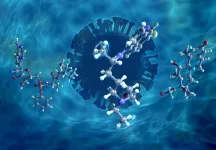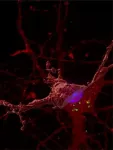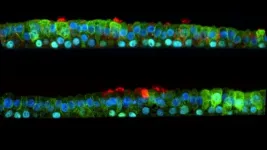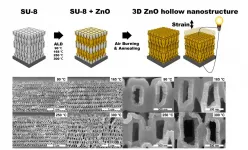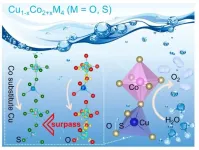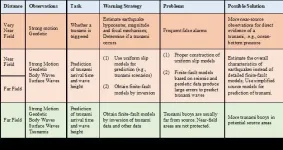(Press-News.org) In the United States only about 1.3 percent of all vehicles sold last year were battery powered. And about 90 percent of those sales were by one company -- Tesla. What has Tesla done right and where have other electric vehicle makers gone wrong?
Electric vehicles cannot succeed without developing a nationwide network of fast-charging networks in parallel with the cars. Current EV business models are doomed unless manufacturers that have bet their futures on them, like General Motors and VW, invest in or coordinate on a robust supercharger network. These are the observations in an in-depth study of the industry by management professors at the University of California, Davis, and Dartmouth College.
The researchers explain that big and traditional automakers have made exciting EVs but have essentially ignored the charging station side of the equation. Meanwhile, Tesla worked both sides of the market by building a sufficiently wide network of high-speed charging stations before they sold too many cars. There are about 4,000 high-voltage super-fast charging stations in the U.S., and the majority of them are available only to Tesla vehicles.
"Tesla has played the platform game. Other automakers are still playing a product game," said Hemant Bhargava, a professor of technology management at the UC Davis Graduate School of Management. "This advantage that Tesla has is not permanent. Other automakers are collectively investing $200 billion in their new electric models. If they put only a few billion dollars, in a coordinated way, into rolling out a supercharging network, they could have enough stations to be competitive."
Bhargava and his co-authors compare the EV industry to various other platform-based products, such as smartphones, which are not nearly so useful without a mobile data network that delivers high-speed connectivity outside the home.
The article, "The Business of Electric Vehicles: A Platform Perspective," was published recently in Foundations and Trends in Technology, Information and Operations Management. The authors are Hemant K. Bhargava, UC Davis Graduate School of Management; Jonas Boehm and Geoffrey G. Parker, Dartmouth College. Bhargava directs the UC Davis Center for Analytics and Technology in Society, which focuses on platform business.
The researchers contend that elected officials and public policymakers have called for a rapid shift toward EVs from traditional gasoline-powered transportation and have set ambitious goals. Increasingly, these policies and goals are backed by research and evolving public sentiment, with buyers willing to pay premium prices for EVs. But, the authors submit, "where do they charge up?" The lack of charging infrastructure has throttled adoption of EVs. About 17 million automobiles were sold in the United States in 2019, of which only about 245,000 were battery-powered electric vehicles, researchers said.
General Motors, the researchers said, spent $1 billion developing its first electric car, and another $1.2 billion developing the Chevy Volt, and Nissan has spent $5.6 billion developing its electric passenger cars. With the major automakers promising new EV models, Bloomberg New Energy Finance predicts that 500 different EV models will be available globally by 2022. The lack of a robust charging network for them will be even more of a glaring omission, Bhargava said.
"There's a chicken-and-egg problem here," Bhargava explained. "Charging station providers will not invest huge amount of money in stations until there are enough cars on the road. But you won't have mass sales of cars until there are enough stations."
Meanwhile, Tesla split its investments on both sides of the market and developed the charging infrastructure in parallel -- a necessary element of their success, the researchers said.
"The huge charging station network is one of Tesla's great competitive advantages," said Bhargava.
Despite likely being defensible in the short run, it is very unlikely that proprietary charging networks are defensible in the long run and the likely low profits make this complement rather unattractive to defend, the researchers concluded.
"I would expect that in about 10 years, as the total EVs on the road grow substantially, there will be a force for universal or industry-wide charging stations, like we have today for refueling stations," Bhargava said.
INFORMATION:
Download the paper: "The Business of Electric Vehicles: A Platform Perspective" https://www.nowpublishers.com/article/Details/TOM-097
Resources:
Video: https://youtu.be/J4LzzNn2TjU
Read the authors' Harvard Business Review article: "How Tesla's Charging Stations Left Other Manufacturers in the Dust"
https://hbr.org/2021/01/how-teslas-charging-stations-left-other-manufacturers-in-the-dust
As the scientific community continues researching the novel coronavirus, experts are developing new drugs and repurposing existing ones in hopes of identifying promising candidates for treating symptoms of COVID-19.
Scientists can analyze the molecular dynamics of drug molecules to better understand their interactions with target proteins in human cells and their potential for treating certain diseases. Many studies examine drug molecules in their dry, powder form, but less is known about how such molecules behave in a hydrated environment, which is characteristic of human cells.
Using neutron experiments and computer ...
University of Queensland researchers have discovered a new 'seeding' process in brain cells that could be a cause of dementia and Alzheimer's disease.
UQ's Queensland Brain Institute dementia researcher Professor Jürgen Götz said the study revealed that tangled neurons, a hallmark sign of dementia, form in part by a cellular process that has gone astray and allows a toxic protein, tau, to leak into healthy brain cells.
"These leaks create a damaging seeding process that causes tau tangles and ultimately lead to memory loss and other impairments," Professor Götz said.
Professor Götz said until now researchers did not understand how tau seeds were able to escape after ...
Research into a new drug which primes the immune system in the respiratory tract and is in development for COVID-19 shows it is also effective against rhinovirus. Rhinovirus is the most common respiratory virus, the main cause of the common cold and is responsible for exacerbations of chronic respiratory diseases such as asthma and chronic obstructive pulmonary disease. In a study recently published in the European Respiratory Journal (LINK), the drug, known as INNA-X, is shown to be effective in a pre-clinical infection model and in human airway cells.
Treatment with INNA-X prior to infection with rhinovirus significantly reduced viral load and inhibited harmful inflammation.
University of Newcastle and Hunter Medical Research Institute (HMRI) researcher Associate Professor ...
With the importance of non-contact environments growing due to COVID-19, tactile electronic devices using haptic technology are gaining traction as new mediums of communication.
Haptic technology is being applied in a wide array of fields such as robotics or interactive displays. haptic gloves are being used for augmented information communication technology. Efficient piezoelectric materials that can convert various mechanical stimuli into electrical signals and vice versa are a prerequisite for advancing high-performing haptic technology.
A research team led by Professor Seungbum Hong confirmed the potential of tactile devices by developing ceramic piezoelectric materials that are three times more deformable. For the fabrication of highly deformable nanomaterials, the ...
A recent study from Oregon State University has found that to best help kids with autism maintain healthy rates of physical activity, interventions should be targeted during the ages of 9 to 13, as that's when kids show the biggest drop in active time.
The study is one of the first to look at this issue on a longitudinal scale. It relied on a dataset of families in Ireland spanning three in-depth interviews between 2007 and 2016. Kids in the survey had their first interview at age 9, the second at 13 and the third at 17 or 18.
The OSU study compared 88 children with autism to 88 children without autism over the nine-year survey period to gauge both how physical activity changed over time, and how much ...
Oxygen evolution reaction (OER), as a vital half-reaction in some clean energy storage and conversion technologies including rechargeable metal-air batteries, regenerative fuel cells and electrochemical water splitting, has been of crucial importance for exploring highly efficient sustainable energy to substitute exhaustible fossil fuels. Among them, electrochemical water splitting can effectively produce clean and reproducible hydrogen fuels through renewable energy sources as power input like solar energy, etc. Unfortunately, the efficiency of water splitting is mainly impeded by the high anodic overpotential of OER, in which seeking efficient and stable electrocatalysts is highly desirable. It has been considered that spinel-structure materials can be meaningful alternative catalysts ...
Tsunamis are one of the most destructive disasters in the ocean. Large tsunamis are mostly generated by earthquakes, and they can propagate across the ocean without significantly losing energy. During the shoaling process in coastal areas, the wave amplitude increases dramatically, causing severe life loss and property damage. There have been frequent tsunamis since the 21st century, drawing the attention of many countries on the study of tsunami mechanism and warning. Tsunami records also play an essential role in deriving earthquake rupture models in subduction zones.
A recent paper entitled "Tsunamis and tsunami warning: recent progress and future prospects" by Dr. Chao An from Shanghai Jiao Tong University reviews the recent research progress of earthquake-generated ...
Sedative medications used in intensive care are associated with increased delirium, which is in turn connected with higher medical costs and greater risk of death and ICU-related dementia.
A study published today in the New England Journal of Medicine provides the most definitive evidence to date that, of the two drugs recommended for light sedation of patients receiving mechanical ventilation in the ICU, one is as effective and safe as the other.
Mechanical ventilation is a life-saving intervention often involving a breathing tube inserted in the patient's windpipe, typically entailing light sedation to quell the attendant discomfort, anxiety and psychological stress. Several studies have sought evidence of which ...
Boston, Mass. - COVID-19 has caused more than 2 million deaths worldwide since the World Health Organization declared it a pandemic in March 2020. Patients with severe COVID-19 frequently experience respiratory distress and require assistance breathing. For patients whose lungs are so injured that even a ventilator is unable to deliver enough oxygen, extracorporeal membrane oxygenation (ECMO) -- which does the work of the lungs by removing carbon dioxide and adding oxygen to blood outside the body -- may improve the odds of survival for certain patients with severe COVID-19.
A study by physician-researchers at Beth Israel Deaconess Medical Center (BIDMC) and Brigham and Women's Hospital (BWH) provides new evidence that critically ill patients with ...
FOLSOM, Calif., February 2, 2021 - Researchers, from the Harvard T.H. Chan School of Public Health in collaboration with investigators from Rovira i Virgili University and the University of Navarra, Spain, used machine learning models, a subset of artificial intelligence, to identify more precisely the components in walnuts that may be responsible for potentially reducing the risk of type 2 diabetes and cardiovascular diseases - two of the leading causes of death in the U.S.
This study, supported by the California Walnut Commission and published in the Journal of Nutrition, used a novel machine learning model to identify 19 metabolites that were associated with walnut consumption. The body forms specific metabolites based on what food is consumed. The walnut ...
